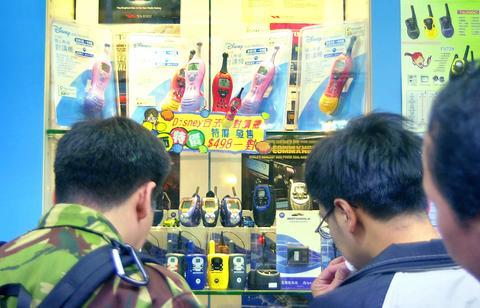As if 6.8 million mobile phones weren't enough -- that's one for every man, woman and child in Hong Kong -- people here are now finding a new way to talk while they walk: The walkie-talkie.
Fans say the two-way radios are good for chatting up new friends or listening in on strangers.

PHOTO: AP
Some wear them like wristwatches, recalling the old Dick Tracy comics, as gadget-crazy Hong Kongers snap up thousands of walkie-talkies to satisfy their irresistible urge to stay continually connected.
The trend has been gaining momentum since the government relaxed controls on walkie-talkies earlier this year. Consumers can now use devices with a range of up to 3km without a license, and new frequencies are open to the public.
"It's fun, but practical, too," said financial analyst Andrew Lam, who recently bought a two-way radio for around HK$350 (US$45) after his friends started using them. They said they enjoyed the novelty of talking with strangers.
Lam, 40, said he bought the walkie-talkie mainly for hiking trips, but soon started tuning in on other people's conversations -- apparently without any luck at tapping into juicy ones.
"I was nosy and wanted to see what other people were talking about," Lam said. "They usually talk about general stuff. People would ask: `Is somebody here?' But I wouldn't respond."
The craze isn't threatening Hong Kong's ubiquitous mobile phones -- which still ring in restaurants, cinemas and church services -- but walkie-talkie dealers are happily counting their sales.
At Hong Kong-based manufacturer Tsuen Shing Enterprises, spokeswoman Rosanna Chan reported sales of more than 10,000 sets in October -- five times as many as in September.
At Motorola Asia Pacific, marketing and communications manager Mildred Wong estimated sales of at least 48,000 sets since February. Business is growing as Christmas nears, she said.
Customers are not just trendy hobbyists, but businesses like fashion chain stores whose staffers need to communicate between departments.
Some popular walkie-talkie models let users scan channels, setting up conversations that could be described as a cross between an Internet room and a mobile phone call.
Walkie-talkie fan Leo Lam said he and his girlfriend use theirs like short-range mobile phones when they're overseas -- avoiding expensive cell phone roaming charges.
"I got them for my girlfriend and me before our trip to Shanghai," said Lam, a 27-year-old translator who spent HK$350 on a pair of walkie-talkies that can be worn like wristwatches.

Former Nicaraguan president Violeta Chamorro, who brought peace to Nicaragua after years of war and was the first woman elected president in the Americas, died on Saturday at the age of 95, her family said. Chamorro, who ruled the poor Central American country from 1990 to 1997, “died in peace, surrounded by the affection and love of her children,” said a statement issued by her four children. As president, Chamorro ended a civil war that had raged for much of the 1980s as US-backed rebels known as the “Contras” fought the leftist Sandinista government. That conflict made Nicaragua one of

COMPETITION: The US and Russia make up about 90 percent of the world stockpile and are adding new versions, while China’s nuclear force is steadily rising, SIPRI said Most of the world’s nuclear-armed states continued to modernize their arsenals last year, setting the stage for a new nuclear arms race, the Stockholm International Peace Research Institute (SIPRI) said yesterday. Nuclear powers including the US and Russia — which account for about 90 percent of the world’s stockpile — had spent time last year “upgrading existing weapons and adding newer versions,” researchers said. Since the end of the Cold War, old warheads have generally been dismantled quicker than new ones have been deployed, resulting in a decrease in the overall number of warheads. However, SIPRI said that the trend was likely

NUCLEAR WARNING: Elites are carelessly fomenting fear and tensions between nuclear powers, perhaps because they have access to shelters, Tulsi Gabbard said After a trip to Hiroshima, US Director of National Intelligence Tulsi Gabbard on Tuesday warned that “warmongers” were pushing the world to the brink of nuclear war. Gabbard did not specify her concerns. Gabbard posted on social media a video of grisly footage from the world’s first nuclear attack and of her staring reflectively at the Hiroshima Peace Memorial. On Aug. 6, 1945, the US obliterated Hiroshima, killing 140,000 people in the explosion and by the end of the year from the uranium bomb’s effects. Three days later, a US plane dropped a plutonium bomb on Nagasaki, leaving abut 74,000 people dead by the

Indian Prime Minister Narendra Modi is to visit Canada next week, his first since relations plummeted after the assassination of a Canadian Sikh separatist in Vancouver, triggering diplomatic expulsions and hitting trade. Analysts hope it is a step toward repairing ties that soured in 2023, after then-Canadian prime minister Justin Trudeau pointed the finger at New Delhi’s involvement in murdering Hardeep Singh Nijjar, claims India furiously denied. An invitation extended by new Canadian Prime Minister Mark Carney to Modi to attend the G7 leaders summit in Canada offers a chance to “reset” relations, former Indian diplomat Harsh Vardhan Shringla said. “This is a